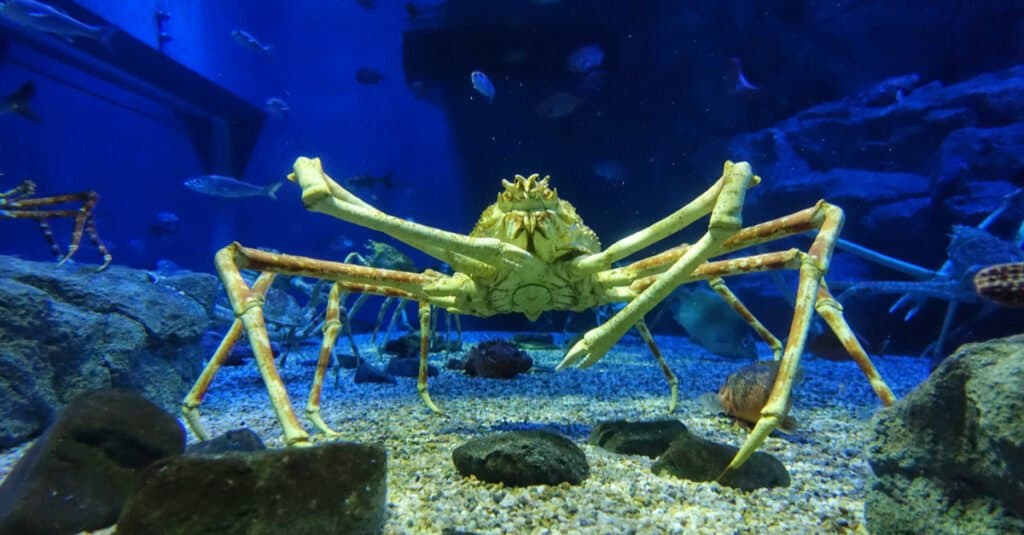Are you prepared for an incredible exploration into the depths of the ocean? Get ready to witness nature's most extraordinary creations as we explore the world of the rarest deep sea creatures. Join us on an exciting journey into the depths of the ocean, where fascinating and elusive beings await. It's a captivating adventure you won't want to miss!
Unveiling the Enigmatic Deep Sea Creatures: From Peacock Squid to Japanese Spider Crab
1. Peacock squid (Taonius sp.)

- Size: The peacock squid (Taonius sp.) can vary in size, with a notable characteristic being its large eyeballs that bulge from its head.
- Mantle length: The specific mantle length of the peacock squid can vary depending on the individual.
- Depth: These squids are found in the deep midwater, typically below 300 meters (almost 1,000 feet), inhabiting the dark and mysterious depths of the ocean.
- Unique physical features: The peacock squid possesses photophores, or light organs, located under its eyes. This feature adds to its intriguing appearance and aids in bioluminescent communication.
- Elusive nature: Due to their preferred habitat in the deep midwater, peacock squid can be elusive and challenging to study or observe.
- Mysterious behaviors: These squids are often observed hanging motionless in the water with their arms raised above their body, displaying an intriguing behavior that adds to their enigmatic nature.
Source: Peacock squid
2. Barreleye Fish (Macropinna microstoma)

- Animal type: Barreleye fish
- Size: Up to 6 inches (15 cm) in length
- Mantle length: Not applicable (as the Barreleye is a fish, mantle length is specific to cephalopods)
- Habitat: Deep sea, specifically the twilight to midnight zones between 2,000 and 2,600 feet (600 and 800 meters)
- Depth: Found at depths mentioned above
- Unique physical features: The Barreleye is known for its peculiar eyes. It has two bright green upward-pointing orbs that are visible through the transparent dome on its forehead. These eyes can rotate forward when needed, allowing the fish to spot prey above it in the water column.
- Elusive nature: Barreleyes are thought to be solitary creatures and can be difficult to encounter due to their deep-sea habitat.
- Mysterious behaviors: The Barreleye's behavior includes remaining almost motionless in the water, precise manoeuvring facilitated by its large, flat fins, and the ability to see the silhouettes of prey through its ultra-sensitive eyes.
Source: Barreleye
3. Sea angel (Clione sp.)

- Animal type: Invertebrates (swimming snail)
- Habitat: Deep sea, worldwide in cold and temperate waters
- Size: Less than an inch (1-2 cm) in length
- Mantle length: Not applicable (sea angels lack a shell)
- Depth: From the surface to 2,000 feet deep (600 meters)
- Unique physical features: Sea angels have a small, transparent, gelatinous body and lack a shell. They possess wing-like structures called parapodia that aid in swimming.
- Elusive nature: Sea angels are often difficult to spot due to their small size and transparent appearance. They blend into their surroundings, making them elusive to observers.
- Mysterious behaviors: Sea angels exhibit intriguing behaviors, such as using finger-like tentacles to capture their prey and utilizing hook-like appendages to extract prey from their shells. They are capable of fast and agile swimming, using a sculling motion.
Source: Sea angel
4. Tardigrade (Tardigrada)

- Animal type: Tardigrade (Tardigrada)
- Size: Nearly microscopic (specific size not mentioned)
- Mantle length: Not applicable (Tardigrades have a puffy body structure)
- Depth: Ocean depths up to 15,000 meters below the surface
- Unique physical features: Eight legs, puffy bodies resembling caterpillars
- Elusive nature: Tardigrades can be found in various habitats, including deep-sea environments.
- Mysterious behaviors: Tardigrades exhibit remarkable resilience and survival abilities, such as transforming into dehydrated balls (tuns) to withstand extreme conditions.
5. Japanese Spider Crab (Macrocheira kaempferi)

- Animal type: Japanese Spider Crab (Macrocheira kaempferi)
- Size: Largest arthropod known to man (specific size not mentioned)
- Mantle length: Not applicable (Crabs have a distinct body structure)
- Depth: Found in the waters surrounding Japan (specific depth not mentioned)
- Unique physical features: Large size, long legs, and a distinctive crab-like appearance
- Elusive nature: Japanese Spider Crabs inhabit specific regions, such as the waters surrounding Japan.
- Mysterious behaviors: Japanese Spider Crabs are opportunistic feeders, consuming a wide range of animals and plants. They use camouflage to capture unsuspecting prey.
Source: 10 Deep Sea Creatures: Discover the Rarest Scariest Animals Beneath the Seas!
A Glance: 5 Unfolding Unseen Wild and Wonderful Deep Sea Creatures!
[video width="1920" height="1080" mp4="https://exhaustivehunt.com/wp-content/uploads/2023/06/Unveiling-Unseen-Wonders-5-Uniquely-Rare-Deep-Sea-Creatures.mp4"][/video]
The world of deep-sea creatures holds a treasure trove of fascinating and mysterious beings. From the Peacock squid to the Barreleye Fish, Sea Angel, Tardigrade, and Japanese Spider Crab, each creature offers a unique glimpse into the wonders of the ocean's depths. Prepare yourself for an incredible exploration and marvel at nature's extraordinary creations.
So, Are you ready to dive into this captivating adventure?
মন্তব্যসমূহ
একটি মন্তব্য পোস্ট করুন